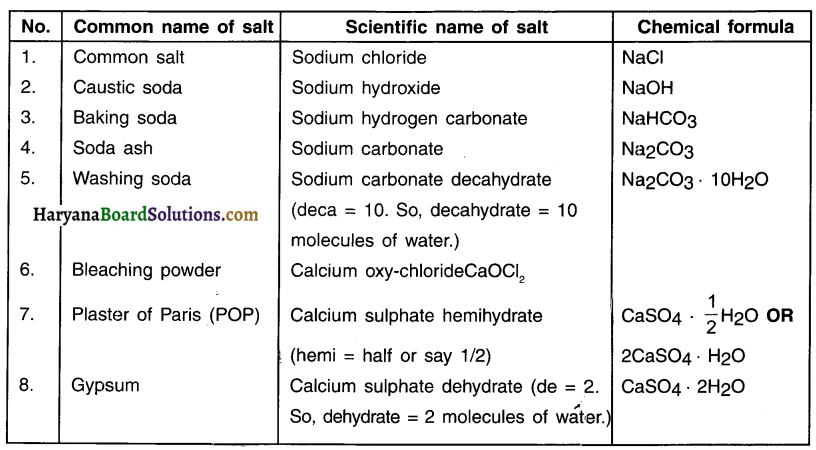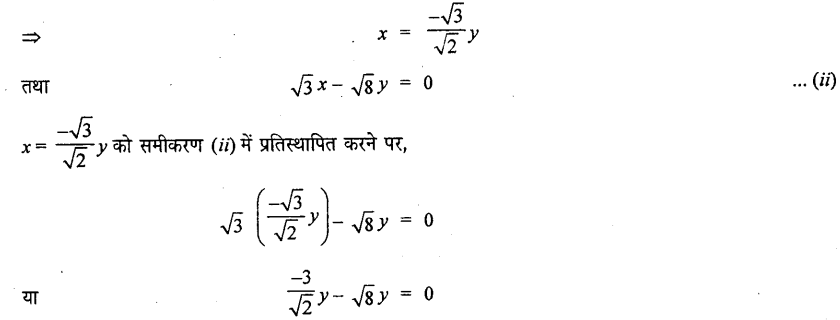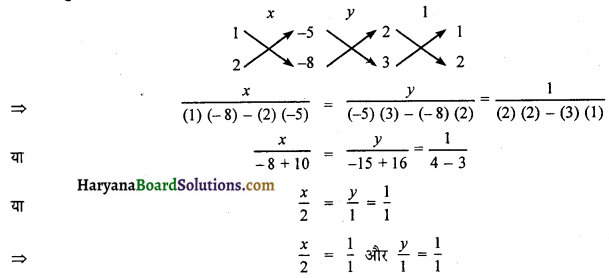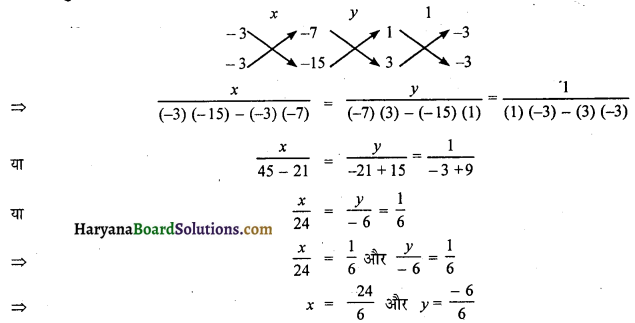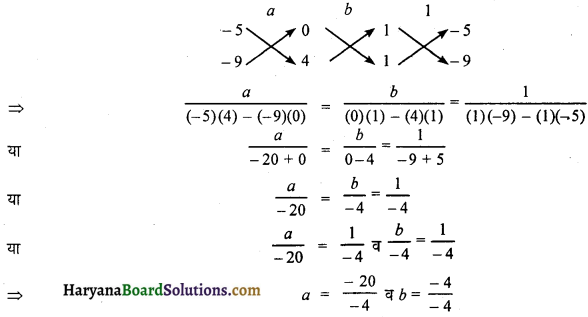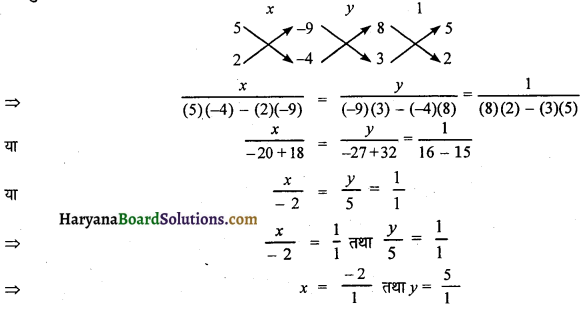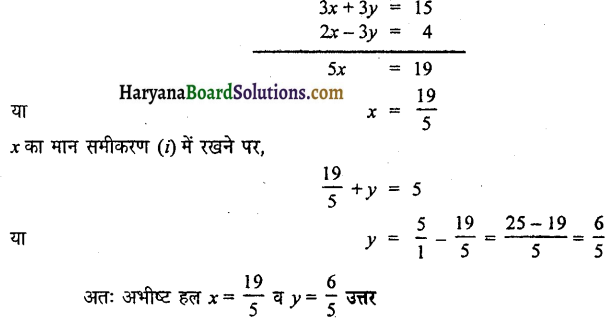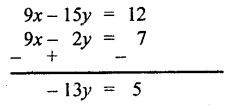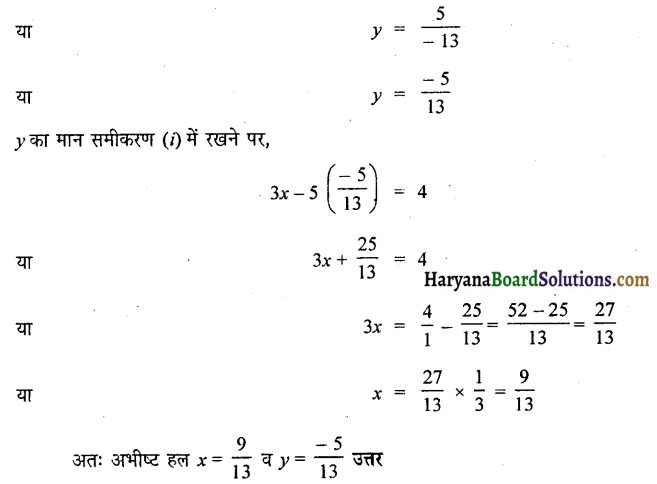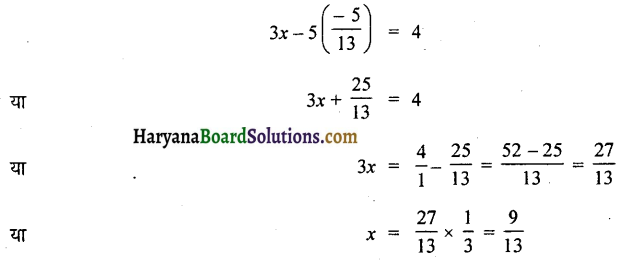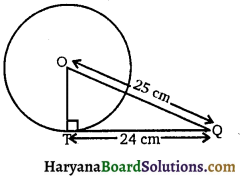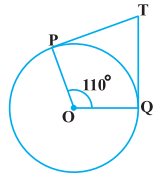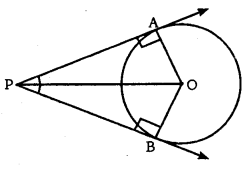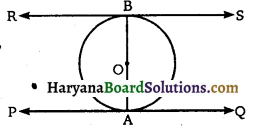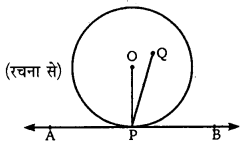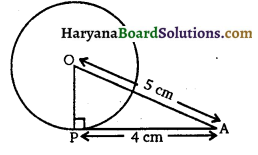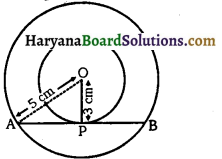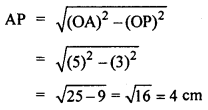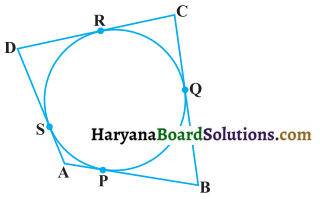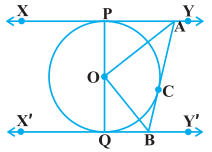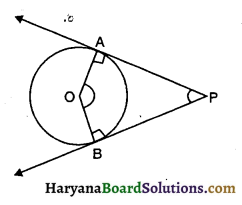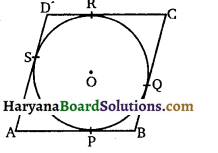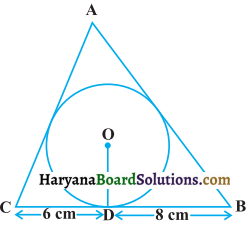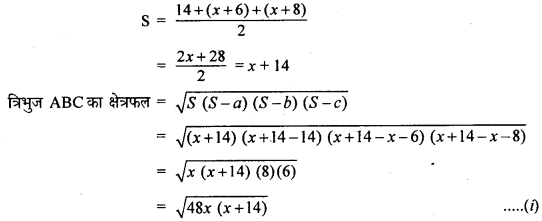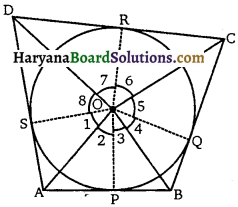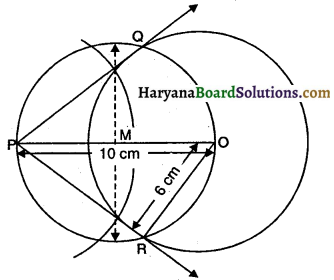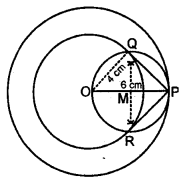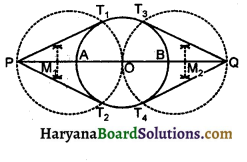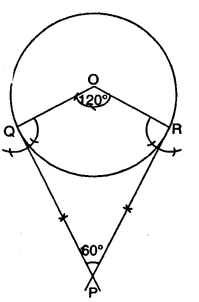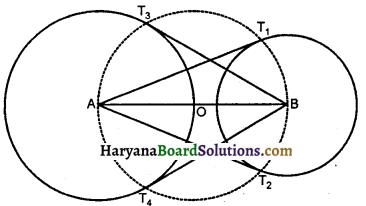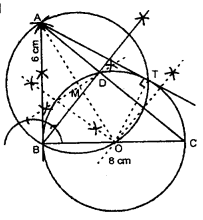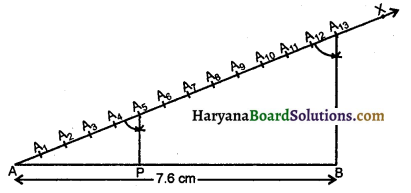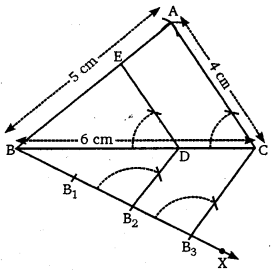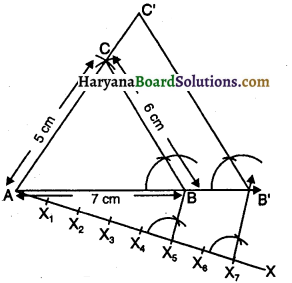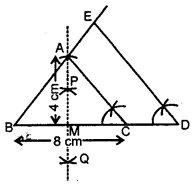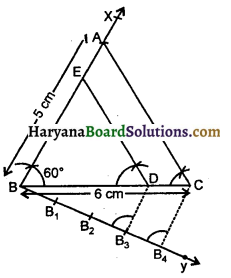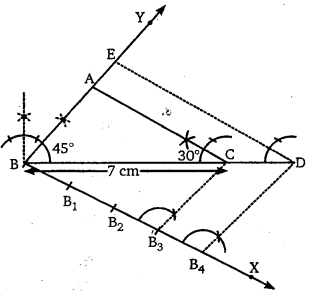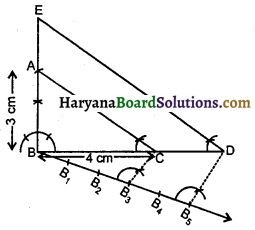Haryana State Board HBSE 10th Class Sanskrit Solutions Shemushi Chapter 11 प्राणेभ्योऽपि प्रियः सुहृदः Textbook Exercise Questions and Answers.
Haryana Board 10th Class Sanskrit Solutions Shemushi Chapter 11 प्राणेभ्योऽपि प्रियः सुहृदः
HBSE 10th Class Sanskrit प्राणेभ्योऽपि प्रियः सुहृदः Textbook Questions and Answers
प्रश्न 1.
अधोलिखितप्रश्नानाम् उत्तराणि संस्कृतभाषया लिखत
(अधोलिखित प्रश्नों के उत्तर संस्कृतभाषा में लिखिए-)
(i) चन्दनदासः कस्य गृहजनं स्वगृहे रक्षति स्म ?
(ii) तृणानां केन सह विरोधः अस्ति ?
(iii) कः चन्दनदासं द्रष्टुमिच्छति ?
(iv) पाठेऽस्मिन् चन्दनदासस्य तुलना केन सह कृता ?
(v) प्रीताभ्यः प्रकृतिभ्यः प्रतिप्रियं के इच्छन्ति ?
(vi) कस्य प्रसादेन चन्दनदासस्य वणिज्या अखण्डिता ?
उत्तराणि:
(i) चन्दनदासः अमात्यराक्षसस्य गृहजनं स्वगृहे रक्षति स्म।
(ii) तृणानानाम् अग्निना सह विरोधः अस्ति।
(iii) चाणक्यः चन्दनदासं द्रष्टुमिच्छति।
(iv) पाठेऽस्मिन् चन्दनदासस्य तुलना शिविना सह कृता।
(v) प्रीताभ्यः प्रकृतिभ्यः प्रतिप्रियं राजानः इच्छन्ति।
(vi) आर्यस्य प्रसादेन चन्दनदासस्य वणिज्या अखण्डिता।

प्रश्न 2.
स्थूलाक्षरपदानि आधृत्य प्रश्ननिर्माणं कुरुत(स्थूलपदों के आधार पर प्रश्ननिर्माण कीजिए-)
(i) शिविना विना इदं दुष्करं कार्यं कः कुर्यात्।
(ii) प्राणेभ्योऽपि प्रियः सुहृत्।।
(ii) आर्यस्य प्रसादेन मे वणिज्या अखण्डिता।
(iv) प्रीताभ्यः प्रकृतिभ्यः राजानः प्रतिप्रियमिच्छन्ति।
(v) तृणानाम् अग्निना सह विरोधो भवति।
उत्तराणि-(प्रश्ननिर्माणम्)
(i) केन विना इदं दुष्करं कार्यं कः कुर्यात् ?
(ii) प्राणेभ्योऽपि प्रियः कः ?
(iii) कस्य प्रसादेन मे वणिज्या अखण्डिता ?
(iv) प्रीताभ्यः प्रकृतिभ्यः के प्रतिप्रियमिच्छन्ति ?
(v) केषाम् अग्निना सह विरोधो भवति ?
प्रश्न 3.
निर्देशानुसारं सन्धिं/सन्धिविच्छेदं कुरुत
(निर्देशानुसार सन्धि/सन्धिविच्छेद कीजिए-)
(क) यथा- कः + अपि – कोऽपि
प्राणेभ्यः + अपि – …………….
…………….. + अस्मि – सज्जोऽस्मि।
आत्मनः + …………….. – आत्मनोऽधिकारसदृशम्
(ख) यथा- सत् + चित् – सच्चित्
शरत् + चन्द्रः – कदाचित् + च
उत्तराणि
(क) यथा- कः + अपि – कोऽपि
प्राणेभ्यः + अपि – प्राणेभ्योऽपि
सज्जः + अस्मि – सज्जोऽस्मि।
आत्मनः + अधिकारसदृशम् – आत्मनोऽधिकारसदृशम्
(ख) यथा-. सत् + चित्
सच्चित् शरत् + चन्द्रः – शरच्चन्द्रः
कदाचित् + च – कदाचिच्च।

प्रश्न 4.
अधोलिखितवाक्येषु निर्देशानुसारं परिवर्तनं कुरुत
(अधोलिखित वाक्यों में निर्देश के अनुसार परिवर्तन कीजिए-)
यथा-प्रतिप्रियमिच्छन्ति राजानः। प्रतिप्रियमिच्छति राजा। (एकवचने)
(i) सः प्रकृतेः शोभां पश्यति (बहुवचने)
(ii) अहं न जानामि। (मध्यमपुरुषैकवचने)
(iii) त्वं कस्य गृहजनं स्वगृहे रक्षसि ? (उत्तमपुरुषैकवचने)
(iv) कः इदं दुष्करं कुर्यात् ? (प्रथमपुरुषैबहुवचने)
(v) चन्दनदासं द्रष्टुमिच्छामि। (प्रथमपुरुषैकवचने)
(vi) राजपुरुषाः देशान्तरं व्रजन्ति। (प्रथमपुरुषैकवचने)
उत्तराणि
(i) ते प्रकृतेः शोभां पश्यन्ति।
(ii) त्वं न जानासि।
(iii) अहं कस्य गृहजनं स्वगृहे रक्षामि ?
(iv) के इदं दुष्करं कुर्युः ?
(v) चन्दनदासं द्रष्टुमिच्छति।
(vi) राजपुरुषः देशान्तरं व्रजति।

प्रश्न 5.
कोष्ठकेषु दत्तयोः पदयोः शुद्धं विकल्पं विचित्य रिक्तस्थानानि पूरयत
(कोष्ठक में दिए गए पदों में से शुद्ध विकल्प चुन कर रिक्तस्थानों की पूर्ति कीजिए-)
(i) ……….. विना इदं दुष्करं कः कुर्यात्। (चन्दनदासस्य / चन्दनदासेन)
(ii) …………… इदं वृत्तान्तं निवेदयामि। (गुरवे / गुरोः)
(ii) आर्यस्य ………… अखण्डिता मे वणिज्या। (प्रसादात् / प्रसादेन)
(iv) अलम् ………..। (कलहेन / कहलात्)
(v) वीरः ………. बालं रक्षति। (सिंहेन / सिंहात्)
(vi) ………… भीतः मम भ्राता सोपानात् अपतत्। (कुक्कुरेण / कुक्कुरात्)
(vii) छात्रः …………….. प्रश्नं पृच्छति। (आचार्यम् / आचार्येण)
उत्तराणि
(i) चन्दनदासेन विना इदं दुष्करं कः कुर्यात् ।
(ii) गुरवे इदं वृत्तान्तं निवेदयामि।
(iii) आर्यस्य प्रसादेन अखण्डिता मे वणिज्या।
(iv) अलं कलहेन।
(v) वीरः सिंहात् बालं रक्षति।
(vi) कुक्कुरात् भीतः मम भ्राता सोपानात् अपतत्।
(vii) छात्रः आचार्य प्रश्नं पृच्छति।।

प्रश्न 6.
अधोदत्तमञ्जूषातः समुचितपदानि गृहीत्वा विलोमपदानि लिखत
(नाचे दी गई मञ्जूषा से समुचित पद लेकर विलोम पद लिखिए-)
आदरः असत्यम् गुणः पश्चात् तदानीम् तत्र
(i) अनादरः ………………………………..
(ii) दोषः ………………………………..
(iii) पूर्वम् ………………………………..
(iv) सत्यम् ………………………………..
(v) इदानीम् ………………………………..
(vi) अत्र ………………………………..
उत्तराणि
(i) अनादरः – आदरः
(ii) दोषः – गुणः
(iii) पूर्वम् – पश्चात्
(iv) सत्यम् – असत्यम्
(v) इदानीम् – तदानीम्
(vi) अत्र – तत्र

प्रश्न 7.
उदाहरणमनुसृत्य अधोलिखितानि पदानि प्रयुज्य पञ्चवाक्यानि रचयत
(उदाहरण के अनुसार अधोलिखित पदों का प्रयोग करके पाँच वाक्य बनाइए-)
यथा निष्क्रम्य- शिक्षिका पुस्तकालयात् निष्क्रम्य कक्षां प्रविशति।
(i) उपसृत्य ………………………………..
(ii) प्रविश्य ………………………………..
(iii) द्रष्टुम् ………………………………..
(iv) इदानीम् ………………………………..
(v) अत्र ………………………………..
उत्तराणि-(वाक्यप्रयोगः)
(i) उपसृत्य – बालक: मातरम् उपसृत्य प्रणमति।
(ii) प्रविश्य – बालकाः उद्याने प्रविश्य क्रीडन्ति।
(iii) द्रष्टुम् – त्वं किं द्रष्टुम् इच्छसि ?
(iv), इदानीम् – इदानीम् अहं चलचित्रं द्रष्टुम् इच्छामि।
(v) अत्र – अत्र चलचित्रगृहं नास्ति।

योग्यताविस्तारः
कविपरिचयः’मुद्राराक्षसम्’ इति नाम्नः नाटकस्य प्रणेता विशाखदत्तः आसीत्। सः राजवंशे उत्पन्नः आसीत्। तस्य पिता भास्करदत्तः महाराजस्य पदवी प्राप्नोत्। विशाखदत्तः राजनीतेः न्यायस्य ज्योतिषविषयस्य च विद्वान् आसीत्। वैदिकधर्मावलम्बी भूत्वाऽपि सः बौद्धधर्मस्य अपि आदरमकरोत्।
कवि परिचय-‘मुद्राराक्षसम्’ इस नाम के नाटक के रचयिता विशाखदत्त थे। वे राजवंश में उत्पन्न हुए थे। उनके पिता भास्करदत्त ने महाराज की पदवी प्राप्त की थी। विशाखदत्त राजनीति, न्याय और ज्योतिष विषय के विद्वान् थे। वैदिक धर्मावलम्बी होकर भी वे बौद्धधर्म का भी आदर करते थे।
ग्रन्थपरिचयः- ‘मुद्राराक्षसम्’ एकम् ऐतिहासिकं नाटकम् अस्ति। दशाङ्केषु विरचिते अस्मिन्नाटके चाणक्यस्य राजनीतिककौशलस्य बुद्धिवैभवस्य राष्ट्रसञ्चालनार्थम् कूटनीतीनाम् निदर्शनमस्ति। अस्मिन्नाटके चाणक्यस्यामात्यराक्षसस्य च कूटनीत्योः संघर्षः।
‘मुदाराक्षसम्’ एक ऐतिहासिक नाटक है। दश अंकों में रचित इस नाटक में चाणक्य के राजनीतिक कौशल, बुद्धि वैभव और राष्ट्र संचालन के लिए उनकी कूटनीतियों का निदर्शन है। इस नाटक में चाणक्य और अमात्य राक्षस की कूटनीतियों का संघर्ष है।
भावविस्तार:
चाणक्य-चाणक्यः एकः विद्वान् ब्राह्मणः आसीत्। तस्य पितृप्रदत्तं नाम विष्णुगुप्तः आसीत्। अयमेव ‘कौटिल्य’ इति नाम्ना प्रसिद्धः केषाञ्चित् विदुषाम् इदमपि मतमस्ति यत् राजनीतिशास्त्रे कुटिलनीतेः प्रतिष्ठापनाय तस्याः स्व-जीवने उपयोगाय च अयं ‘कौटिल्यः’ इत्यपि कथ्यते। चणकनामकस्य कस्यचित् आचार्यस्य पुत्रत्वात् ‘चाणक्यः’ इति नाम्ना स प्रसिद्धः जातः । नन्दानां राज्यकालः शतवर्षाणि पर्यन्तम् आसीत्। तेषु अन्तिमेषु द्वादशवर्षे एतेन सुमाल्यादीनाम् अष्टनन्दानां संहारः कारितः तथा च चन्द्रगुप्तमौर्यः नृपत्वेन राजसिंहासने स्थापितः। अयमेकः महान् राजनीतिज्ञः आसीत्। एतेन भारतीयशासनव्यवस्थायाः प्रामाणिकतत्त्वानां वर्णनेन युक्तं “अर्थशास्त्रम्” इति अतिमहत्त्वपूर्णः ग्रन्थः रचितः।
चन्द्रगुप्तमौर्यः-चन्द्रगुप्तः महापद्मनन्दस्य मुरायाः च पुत्रः आसीत्। चाणक्यस्य मार्गदर्शने अनेन चतुर्विंशतिवर्षपर्यन्तं राज्यं कृतम्।। राक्षसः-नन्दराज्ञः स्वामिभक्तः चतुरः प्रधानामात्यः आसीत्। चन्दनदासः-कुसुमपुर-नाम्नि नगरे महामात्यस्य राक्षसस्य प्रियतमं पात्रं मित्रञ्च आसीत्। स मणिकारः श्रेष्ठी च आसीत्। अस्यैव गृहात् राक्षसः सपरिवार: नगरात् बहिरगच्छत्।
चाणक्य-चाणक्य एक विद्वान ब्राह्मण था। उसके पिता द्वारा दिया गया नाम विष्णुगुप्त था। यह ही कौटिल्य इस नाम से प्रसिद्ध हुआ। कुछ विद्वानों का यह भी मत है कि राजनीति शास्त्र में कूटनीति की प्रतिष्ठापना के लिए और उसका अपने जीवन में उपयोग करने के लिए इन्हें ‘कौटिल्य’ कहा जाता है।
चणक नामक किसी आचार्य का पुत्र होने के कारण वे ‘चाणक्य’ इस नाम से प्रसिद्ध हुए। नन्दों का राज्य काल 100 वर्षों तक रहा। उनमें अन्तिम 12 वर्षों में इन (चाणक्य) के द्वारा सुमाल्य आदि आठ नन्दों का विनाश करवाया गया और चन्द्रगुप्त मौर्य को राजा के रूप में राजसिंहासन पर बैठाया गया। ये एक महान् राजनीतिज्ञ थे। इन्होंने भारतीय शासन व्यवस्था का प्रामाणिक तत्त्वों के वर्णन से युक्त अर्थशास्त्र नामक अत्यन्त महत्त्वपूर्ण ग्रन्थ की रचना की। चन्द्रगुप्त मौर्य-चन्द्रगुप्त महापद्मनन्द और मुरा का पुत्र था। चाणक्य के मार्गदर्शन में इसने 24 वर्ष तक राज्य किया।
राक्षस-राजा नन्द का स्वामीभक्त चतुर प्रधान अमात्य था। चन्दनदास-कुसुमपुर नामक नगर में महामात्य राक्षस का सबसे प्रिय पात्र और मित्र था। वह सुवर्णकार और सेठ था। इसी के घर से राक्षस परिवार सहित नगर से बाहर गया था।

भाषिक विस्तारः
1. पृथक् और विना शब्दों के योग में द्वितीया तृतीया और पंचमी तीनों विभक्तियों का प्रयोग
यथा-जलं विना जीवनं न सम्भवति। द्वितीया
जलेन विना जीवनं न सम्भवति । तृतीया
जलात् विना जीवनं न सम्भवति। पञ्चमी
परिश्रमं पृथक् नास्ति सुखम्। द्वितीया
परिश्रमात् पृथक् नास्ति सुखम्। पञ्चमी
2. अनीयर् प्रत्ययप्रयोगः
अत्यादरः – शङ्कनीयः
जन्तुशाला – दर्शनीया
याचकेभ्यः दानं – दानीयम्
वेदमन्त्राः – स्मरणीयाः
पुस्तकमेलापके पुस्तकानि – क्रयणीयानि।
(क) अनीयर् प्रत्ययस्य प्रयोगः योग्यार्थे भवति।
(ख) अनीयर् प्रत्यये ‘अनीय’ इति अवशिष्यते।
(ग) अस्य रूपाणि त्रिषु लिङ्गेषु चलन्ति।
यथा-
पुंल्लिङ्गे स्त्रीलिङ्गे नपुंसकलिङ्गे
पठनीयः पठनीया पठनीयम्
इनके रूप क्रमशः देववत्, लतावत् तथा फलवत् चलेंगे।
3. उभ सर्वनामपदम् पुल्लिङ्गे नपुंसकलिङ्गे
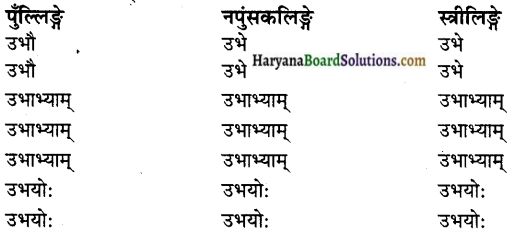
HBSE 10th Class Sanskrit प्राणेभ्योऽपि प्रियः सुहृदः Important Questions and Answers
प्रश्न 1.
अधोलिखितानां वाक्यानां/सूक्तीनां भावार्थं हिन्दीभाषायां लिखत
(अधोलिखित वाक्यों/सूक्तियों के भावार्थ हिन्दीभाषा में लिखिए-)
(क) अत्यादरः शङ्कनीयः’।
(अत्यधिक आदर सन्देह पैदा करता है)
भावार्थ :-‘अत्यादरः शङ्कनीयः’ यह सूक्ति हमारी पाठ्यपुस्तक ‘शेमुषी भाग-2’ में संकलित ‘प्राणेभ्योऽपि प्रियः सुहृद्’ पाठ से उद्धृत की गयी है। यह पाठ महाकवि विशाखदत्त के ‘मुद्राराक्षसम्’ नाटक से लिया गया है। उपर्युक्त सूक्ति में अत्यधिक आदर को सन्देह का कारण बतलाया गया है।
इस सूक्ति का भावार्थ यह है कि यदि कोई व्यक्ति बिना कारण आपके प्रति अत्यधिक आदर प्रदर्शित करता है या जो व्यक्ति अब तक आपके प्रति तटस्थ या शत्रुतापूर्ण व्यवहार करता था और अब अचानक अतीव आदर प्रदर्शित करने लगा है तो समझ लो कि दाल में कुछ काला है। अर्थात् आदर प्रदर्शित करने वाला व्यक्ति कोई न कोई चाल चलने वाला है। पाठ में जब चाणक्य अपने शत्रु (राक्षस) के मित्र चन्दनदास के प्रति अतीव आदरपूर्ण व्यवहार करने लगता है तब चन्दनदास यह कहता है कि चाणक्य में एकाएक आया यह परिवर्तन अवश्य ही इनकी कोई कपटी चाल का हिस्सा है।
भाव यह कि हमें अचानक अत्यधिक आदर करने वाले व्यक्ति के प्रति सचेत होकर रहना चाहिए।
(ख) प्रीताभ्यः प्रकृतिभ्यः प्रतिप्रियमिच्छन्ति राजानः।
(प्रसन्न हुई प्रजाओं से राजा लोग बदले में अपना हित भी करवाना चाहता है)
भावार्थ :-उपर्युक्त सूक्ति हमारी पाठ्यपुस्तक ‘शेमुषी भाग-2’ में संकलित ‘प्राणेभ्योऽपि प्रियः सुहृद्’ पाठ से उद्धृत की गयी है। यह पाठ महाकवि विशाखदत्त के नाटक ‘मुद्राराक्षसम्’ से संकलित है। सूक्ति में राजा और प्रजा के पारस्परिक सम्बन्धों के विषय में बतलाया गया है।
प्रदत्त सूक्ति का भाव यह है कि राजा अपनी प्रजाओं की हर प्रकार की रक्षा करता है और यदि प्रजाएँ राजा के प्रशासन से सर्वथा प्रसन्न हैं तो राजा भी यह आशा करता है कि प्रजायें भी राजा की इच्छा के अनुसार कार्य करें। पाठ में चाणक्य चन्दनदास से पूछता है कि क्या आपका व्यापार ठीक चल रहा है। चन्दनदास कहता है कि बिल्कुल ठीक चल रहा है। चन्द्रगुप्त मौर्य के राज्य में हमें कोई कठिनाई नहीं है। चाणक्य कहता है कि यदि आप उनके प्रशासन से प्रसन्न हैं; तो आप भी राजा का कुछ हित कीजिए। अर्थात् राजा नन्द के मन्त्री राक्षस के जो परिवार चन्दनदास के पास रह रहा है; वह उस परिवार को वर्तमान के राजा चन्द्रगुप्त मौर्य को सौंप दे।
भाव यह कि राजा और प्रजा का पारस्परिक सम्बन्ध उपकार एवं प्रत्युपकार “Give and take” पर आधारित होता है।
कीदृशस्तृणानामग्निना सह विरोधः।
प्रसंग :-“कीदृशस्तृणानामग्निना सह विरोधः” यह सूक्ति हमारी संस्कृत की पाठ्यपुस्तक “शेमुषी भाग-2′ में मुद्राराक्षस नाटक से संकलित पाठ “प्राणेभ्योऽपि प्रियः सुहृद्” से उद्धृत की गयी है। इसमें बड़ों के साथ छोटे कैसे शत्रुता मोल ले सकते हैं; इस तथ्य को प्रकट किया गया है।
सरलार्थ :-तिनकों का अग्नि के साथ विरोध सम्भव नहीं है।
भावार्थ :-ऊपर लिखित सक्ति का भावार्थ यह है कि बड़े छोटों से वैर करें यह तो समझ आ जाता है क्योंकि ऐसा करने पर वे उन्हें सजा आदि देने का सामर्थ्य रखते हैं; परन्तु छोटे बड़ों के साथ वैर या द्वेष रखें यह सम्भव नहीं है क्योंकि उनके पास बड़ों को दण्डित करने का सामर्थ्य नहीं होता है। पाठ में चाणक्य चन्दनदास को कहता है कि आप राजा अर्थात् चन्द्रगुप्त मौर्य का विरोध करना छोड़ दो तब चन्दनदास कहता है कि आप यह क्या कह रहे हैं; मैं राजा का विरोध क्यों करूँगा क्योंकि क्या कभी तिनके अग्नि का विरोध कर सकते हैं अर्थात् कभी नहीं।
अतः जहाँ सूर्य को दीपक दिखाने जैसी बात हो या दो पक्षों में बहुत बड़ा अन्तर हो वहाँ उपर्युक्त सूक्ति का प्रयोग किया जाता है।
(ग) शिरसि भयम् अतिदूरं प्रतिकारः।
(चाणक्य चन्दनदास को धमकी देते हुए कहता है कि-भय आपके सिर पर मण्डरा रहा है और उसका उपाय बहुत दूर है)
भावार्थ :-‘शिरसि भयम् अतिदूरे प्रतिकारः’ यह सूक्ति हमारी संस्कृत की पाठ्यपुस्तक ‘शेमुषी भाग-2’ में संकलित पाठ ‘प्राणेभ्योऽपि प्रियः सुहृद्’ पाठ से उद्धृत की गयी है। इसमें अप्रस्तुत की अपेक्षा प्रस्तुत से लाभ उठाने की बात कही गयी है।
सूक्ति का भावार्थ यह है कि चन्दनदास तुम जिस व्यक्ति (मन्त्री राक्षस) के लिए कार्य कर रहे हो; वह यहाँ नहीं है और आपकी इस समय कोई सहायता भी नहीं कर सकता है जबकि यदि तुम अपने घर पर छुपे हुए मन्त्री के परिवार को हमें सौंप देते हो तो हम आपको सजा देने की अपेक्षा पुरस्कृत भी कर सकते हैं। अब आप निर्णय करो कि वर्तमान का लाभ उठाना है या भविष्य के साथ चिपके रहना है। इस सूक्ति का प्रयोग वर्तमान और भविष्य में से एक का चुनाव करने के विकल्प के रूप में किया जाता है।
सुलभेष्वर्थलाभेषु परसंवेदने जने ।
क इदं दुष्करं कुर्यादिदानीं शिविना विना ॥
प्रसंग :-उपर्युक्त सूक्ति हमारी संस्कृत की पाठ्यपुस्तक ‘शेमुषी भाग-2’ में मुद्राराक्षस नाटक से उद्धृत पाठ ‘प्राणेभ्योऽपि प्रियः सुहृद्’ से ली गयी है। इसमें चन्दनदास की मित्र के प्रति निष्ठा को देखकर उसकी प्रशंसा में कहता है कि आपने तो परोपकार में राजा शिवि की भान्ति आदर्श प्रस्तुत कर दिया।
सरलार्थ :-चाणक्य चन्दनदास की मित्र के प्रति निष्ठा को देखकर कहता है कि-दूसरों की वस्तु के समर्पित करने पर बहुत धन प्राप्त होने की स्थिति में भी दूसरों की वस्तु के सुरक्षा रूपी कठिन कार्य को ‘शिवि’ को छोड़कर तुम्हारे अतिरिक्त दूसरा कौन कर सकता है।
भावार्थ :-ऊपर लिखित सूक्ति का भाव यह है कि धन लोभ का त्याग करके भी धरोहर की रक्षा करना किसी विरले ही महापुरुष के वश की बात होती है। चाणक्य कहता है कि चन्दनदास मन्त्री राक्षस के परिवार को चन्द्रगुप्त मौर्य को सौंप देने पर आप धन और पद की प्राप्ति कर सकते हैं तथापि आप अपनी धरोहर की रक्षा के प्रति वचनबद्ध हैं। ऐसी निष्ठा या तो हमने शिवि द्वारा कबूतर रक्षण में देखी थी या फिर आज आप में देख रहे हैं।
संसार में ऐसे लोग भी विद्यमान हैं जो सब कुछ त्याग कर भी अपने वचन पर अडिग रहते हैं।

प्रश्न 2.
स्थूलपदानि आधृत्य प्रश्ननिर्माणं कुरुत
(स्थूलपदों के आधार पर प्रश्ननिर्माण कीजिए-)
(क) अत्यादरः शङ्कनीयः।
(ख) प्रीताभ्यः प्रकृतिभ्यः प्रतिप्रियमिच्छन्ति राजानः।
(ग) राजनि अविरुद्धवृत्तिर्भव।
(घ) सन्तमपि गेहे अमात्यराक्षस्य गृहजनं न समर्पयामि।
(ङ) नन्दस्यैव अर्थसम्बन्धः प्रीतिम् उत्पादयति।
उत्तराणि-(प्रश्ननिर्माणम्)
(क) अत्यादरः कीदृशः?
(ख) प्रीताभ्यः प्रकृतिभ्यः प्रतिप्रियमिच्छन्ति के?
(ग) कस्मिन् अविरुद्धवृत्तिर्भव?
(घ) सन्तमपि गेहे कस्य गृहजनं न समर्पयामि?
(ङ) नन्दस्यैव अर्थसम्बन्धः किम् उत्पादयति?

प्रश्न 3.
अधोलिखित-प्रश्नानां प्रदत्तोत्तरविकल्पेषु शुद्धं विकल्पं विचित्य लिखत
(अधोलिखित प्रश्नों के उत्तर के लिए दिए गए विकल्पों में से शुद्ध विकल्प चुनकर लिखिए-)
(क) ‘कदाचिच्च’ पदस्य सन्धिविच्छेदोऽस्ति
(i) कदाचित् + च
(ii) कदाचिच् + च
(iii) कदा + चिच्च
(iv) कदाचित + च।
उत्तरम्:
(i) कदाचित् + च।
(ख) ‘प्राणेभ्यः + अपि’ अत्र सन्धियुक्तपदम्
(i) प्राणेभ्योरपि
(ii) प्राणेभ्योऽअपि
(iii) प्राणेभ्योष्वपि
(iv) प्राणेभ्योऽपि।
उत्तरम्:
(iv) प्राणेभ्योऽपि।
(ग) ‘गृहजनम्’ अस्मिन् पदे कः समासोऽस्ति ?
(i) बहुव्रीहिः
(ii) तत्पुरुषः
(ii) अव्ययीभावः
(iv) द्वन्द्वः ।
उत्तरम्:
(ii) तत्पुरुषः
(घ) ‘अपरिक्लेशः’ इति पदस्य समास-विग्रहः
(i) अपरः क्लेशः
(ii) क्लेशम् अनतिक्रम्य
(iii) न परिक्लेशः
(iv) अपरिहार्यः क्लेशः।
उत्तरम्:
(iii) न परिक्लेशः
(ङ) ‘द्रष्टुम्’ इति पदे कः प्रत्ययः ?
(i) त्व
(ii) तल्
(iii) तुमुन्
(iv) क्ता।
उत्तरम्:
(iii) तुमुन्
(च) ………. प्रचीयन्ते संव्यवहारणां वृद्धिलाभाः ?
(रिक्तस्थानपूर्तिः अव्ययपदेन)
(i) अपि
(ii) ह्यः
(iii) न
(iv) च।
उत्तरम्:
(i) अपि
(छ) मम विद्यालये ……… प्रमुखं प्रवेशद्वारम् अस्ति।
(रिक्तस्थानपूर्तिः उचितसंख्यापदेन)
(i) एकम्
(ii) एका
(iii) चतस्रः
(iv) शताधिकम्।
उत्तरम्:
(i) एकम्।
(ज) आर्यस्य प्रसादेन कस्य वणिज्या अखण्डिता ?
(i) अमात्यराक्षसस्य
(ii) चाणक्यस्य
(iii) चन्दनदासस्य
(iv) चन्द्रगुप्तस्य।
उत्तरम्
(iii) चन्दनदासस्य।
(झ) तृणानां केन सह विरोधः भवति ?
(i) जलेन
(ii) अग्निना
(iii) वायुना
(iv) पशुना।
उत्तरम्:
(i) अग्निना
(ज) ‘आर्येण’ अत्र का विभक्तिः प्रयुक्ता ?
(i) प्रथमा
(ii) सप्तमी
(iii) तृतीया
(iv) चतुर्थी।
उत्तरम्:
(iii) तृतीया।

यथानिर्देशम् उत्तरत
(ट) ‘भीताः’ इति पदस्य प्रकृति-प्रत्ययौ लिखत।
(ठ) ‘ननु भवता प्रष्टव्याः स्मः। (अत्र किम् अव्ययपदं प्रयुक्तम्)
(ड) ‘राजनि अविरुद्धवृत्तिर्भव। (‘भव’ अत्र कः लकारः प्रयुक्तः ?)
(ढ) अयम् विद्यालयः 12 कक्षापर्यन्तः अस्ति। (अङ्कस्थाने संस्कृतसंख्यावाचक-विशेषणं लिखत)
(ण) प्राचार्यस्य 2 सहायकौ उपप्राचार्यों स्तः। (अङ्कस्थाने संस्कृतसंख्यावाचकविशेषणं लिखत)
(त) शिविना विना इदं दुष्करं कः कुर्यात्। (रेखाङ्कितपदेन प्रश्ननिर्माणं कुरुत)
उत्तराणि-
(ट) ‘भीताः’ – भी + क्त।
(ठ) ‘ननु’ इति अव्ययपदं प्रयुक्तम्।
(ड) ‘भव’ अत्र लोट् लकारः प्रयुक्तः ।
(ढ) अयम् विद्यालयः द्वादश-कक्षापर्यन्तः अस्ति।
(ण) प्राचार्यस्य द्वौ सहायकौ उपप्राचार्यों स्तः।
(त) केन विना इदं दुष्करं कः कुर्यात् ?

प्राणेभ्योऽपि प्रियः सुहृदः पठित-अवबोधनम्
निर्देशः-अधोलिखितं गद्यांशं पठित्वा एतदाधारितान् प्रश्नानाम् उत्तराणि संस्कृत-पूर्णवाक्येन लिखत
(अधोलिखित गद्यांश को पढ़कर इन पर आधारित प्रश्नों के उत्तर संस्कृत के पूर्ण वाक्य में लिखिए-)
1. चाणक्यः – वत्स ! मणिकारश्रेष्ठिनं चन्दनदासमिदानीं द्रष्टुमिच्छामि। शिष्यः
शिष्यः – तथेति (निष्क्रम्य चन्दनदासेन सह प्रविश्य) इतः इतः श्रेष्ठिन् (उभौ परिक्रामत:)
शिष्यः – (उपसृत्य) उपाध्याय ! अयं श्रेष्ठी चन्दनदासः।
चन्दनदासः -जयत्वार्यः।
चाणक्यः – श्रेष्ठिन् ! स्वागतं ते। अपि प्रचीयन्ते संव्यवहारणां वृद्धिलाभाः ?
चन्दनदासः – (आत्मगतम्) अत्यादरः शङ्कनीयः। (प्रकाशम्) अथ किम्। आर्यस्य प्रसादेन अखण्डिता मे वणिज्या।
चाणक्यः – भो श्रेष्ठिन् ! प्रीताभ्यः प्रकृतिभ्यः प्रतिप्रियमिच्छन्ति राजानः।
चन्दनदासः – आज्ञापयतु आर्यः, किं कियत् च अस्मजनादिष्यते इति।
चाणक्यः – भो श्रेष्ठिन् ! चन्द्रगुप्तराज्यमिदं न नन्दराज्यम्। नन्दस्यैव अर्थसम्बन्धः प्रीतिमुत्पादयति। चन्द्रगुप्तस्य तु भवतामपरिक्लेश एव।
चन्दनदासः – (सहर्षम्) आर्य ! अनुगृहीतोऽस्मि।
पाठ्यांश-प्रश्नोत्तर
(क) पूर्णवाक्येन उत्तरत
(i) चाणक्यः कं द्रुष्टुम् इच्छति ?
(ii) आर्यस्य प्रसादेन कस्य वणिज्या अखण्डिता ?
(iii) अनुगृहीतः कः भवति ?
(iv) कस्य एव अर्थसम्बन्धः प्रीतिम् उत्पादयति ?
(v) अत्यादरः कीदृशः ?
(vi) चन्दनदासः कः अस्ति ?
(vii) किम् इच्छन्ति राजानः ?
उत्तराणि:
(i) चाणक्यः चन्दनदासं द्रुष्टुम् इच्छति।
(ii) आर्यस्य प्रसादेन चन्दनदासस्य वणिज्या अखण्डिता।
(iii) अनुगृहीतः चन्दनदासः भवति।
(iv) नन्दस्य एव अर्थसम्बन्धः प्रीतिम् उत्पादयति।
(v) अत्यादरः शङ्कनीयः।
(vi) चन्दनदासः मणिकारश्रेष्ठी अस्ति।
(vii) प्रीताभ्यः प्रकृतिभ्यः प्रतिप्रियम् इच्छन्ति राजानः ।
(ख) निर्देशानुसारम् उत्तरत
(i) ‘परिक्रामतः’ अत्र कः उपसर्गः प्रयुक्तः ?
(ii) ‘अखण्डिता वणिज्या’-अत्र विशेष्यपदं किम् ?
(ii) ‘व्यापाराणाम्’ इत्यर्थे प्रयुक्तं पदं किम् ?
(iv) ‘अस्मज्जनादिष्यते’-अत्र ‘अस्मत्’ इति सर्वनाम कस्मै प्रयुक्तम् ?
(v) ‘दरिद्रः’ इत्यस्य प्रयुक्तं विलोमपदं किम् ?
उत्तराणि:
(i) परि।
(ii) वणिज्या।
(iii) संव्यवहाराणाम्।
(iv) चन्दनदासाय।
(v) श्रेष्ठी।
हिन्दीभाषया पाठबोधः
शब्दार्था:-मणिकारश्रेष्ठिनम् = (रत्नकारं वणिजम्) मणियों का व्यापारी । निष्क्रम्य = (बहिर्गत्वा) बाहर निकलकर। परिक्रामतः = (परिभ्रमणं कुर्वतः) (दोनों) परिभ्रमण करते है। उपसृत्य = (समीपं गत्वा) पास जाकर। प्रचीयन्ते =(वृद्धिं प्राप्नुवन्ति) बढ़ते हैं । संव्यवहाराणाम् = (व्यापाराणाम्) व्यापारों का। आत्मगतम् = (स्वगतम्) मन-ही-मन। प्रकाशम् = (प्रकटरूपे) प्रकट रूप में। शङ्कनीयः = (सन्देहास्पदम्) शंका करने योग्य। प्रसादेन = (कृपया) कृपा से। अखण्डिता = (निर्बाधा) बाधारहित । वणिज्या = (वाणिज्यम्) व्यापार । प्रीताभ्यः = (प्रसन्नाभ्यः) प्रसन्नजनों के प्रति। प्रतिप्रियम् = (प्रत्युपकारम्) उपकार के बदले किया गया उपकार। अपरिक्लेशः = (दु:खाभाव:) दुःख का अभाव।
प्रसंगः-प्रस्तुत गद्यांश हमारी पाठ्य पुस्तक ‘शेमुषी द्वितीयो भागः’ के ‘प्राणेभ्योऽपि प्रियः सुहृद्’ नामक पाठ से लिया गया है। चाणक्य से भेंट करने के लिए उनकी अनुमति से सेठ चन्दनदास को चाणक्य के सामने लाया जाता है और चाणक्य उसका बहुत आदर करते हुए चन्द्रगुप्त के राज्य में उसके व्यापार की वृद्धि के बारे में पूछता है। इसी का वर्णन प्रस्तुत नाटयांश में है।
सरलार्थः
चाणक्य – पुत्र ! मैं इस समय सुवर्ण व्यापारी सेठ चन्दनदास को देखना (मिलना) चाहता हूँ।
शिष्य – ठीक ही (बाहर निकलकर चन्दनदास के साथ प्रवेश करके) इधर से इधर से सेठ जी ( दोनों घूमते हैं)।
शिष्य – (पास जाकर) उपाध्यायजी ! ये सेठ चन्दनदास हैं।
चन्दनदास – आर्य की जय हो।
चाणक्य – सेठ जी ! आपका स्वागत है। क्या आपके व्यापार-कार्यों की लाभवृद्धियाँ हो रही हैं ?
चन्दनदास – (मन-ही-मन) अत्यधिक आदर शङ्का (सन्देह) के योग्य है। (प्रकट रूप में) और क्या! आर्य की कृपा से मेरा व्यापार परिपूर्ण है।
चाणक्य – अरे सेठ जी ! राजा प्रसन्न हुई अपनी प्रजा से बदले में प्रिय चाहते हैं। अर्थात् राजा का तुम्हारे प्रति जो मृदु व्यवहार है, उसके बदले में वे भी आपसे कुछ प्रिय व्यवहार चाहते हैं।
चन्दनदास – आर्य आज्ञा करें, इस व्यक्ति से क्या और कितना चाहते हैं ?
चाणक्य – अरे सेठजी ! यह चन्द्रगुप्त का राज्य है, न कि नन्द का राज्य। धन का सम्बन्ध नन्द के लिए ही प्रीति उपजाता है। चन्द्रगुप्त के लिए तो आपका दुःख रहित होना ही प्रीतिदायक है।
चन्दनदास – (हर्ष के साथ) आर्य ! अनुगृहीत हुआ हूँ।
भावार्थ:-भाव यह है कि चाणक्य चन्दनदास को आदरपूर्वक मिलने के लिए बुलाता है। चन्दनदास अपने प्रति चाणक्य के अति आदर को शंका की दृष्टि से देखता है। चाणक्य उससे पूछता है कि चन्द्रगुप्त के राज्य में उसका व्यापार फल-फूल रहा है या नहीं। चन्दनदास कहता है कि बिल्कुल ठीक चल रहा है। चन्द्रगुप्त मौर्य के राज्य में हमें कोई कठिनाई नहीं है। चाणक्य कहता है कि यदि आप उनके प्रशासन से प्रसन्न हैं; तो आप भी राजा का कुछ हित कीजिए। क्योंकि राजा और प्रजा का पारस्परिक सम्बन्ध उपकार एवं प्रत्युपकार “Give and take” पर आधारित होता है।
नोट-संस्कृत में वाक्य के आरम्भ में आने वाला ‘अपि’ शब्द प्रश्नवाचक होता है-अपि = किम्। जैसे-अपि कुशलोऽसि ?
‘क्या आप कुशल हैं ?’

2. चाणक्यः भो श्रेष्ठिन् ! स चापरिक्लेशः कथमाविर्भवति इति ननु भवता प्रष्टव्याः स्मः।
चन्दनदासः – आज्ञापयतु आर्यः।
चाणक्यः – राजनि अविरुद्धवृत्तिर्भव।
चन्दनदासः – आर्य ! कः पुनरधन्यो राज्ञो विरुद्ध इति आर्येणावगम्यते ?
चन्दनदासः – (कर्णो पिधाय) शान्तं पापम्, शान्तं पापम्। कीदृशस्तृणानामग्निना सह विरोध: ?
चाणक्यः – अयमीदृशो विरोधः यत् त्वमद्यापि राजापथ्यकारिणोऽमात्यराक्षसस्य गृहजनं स्वगृहे रक्षसि।
चन्दनदासः – आर्य ! अलीकमेतत्। केनाप्यनार्येण आर्याय निवेदितम्।
चाणक्यः – भो श्रेष्ठिन् ! अलमाशङ्कया। भीताः पूर्वराजपुरुषाः पौराणामनिच्छतामपि गृहेषु गृहजनं निक्षिप्य देशान्तरं व्रजन्ति। ततस्तत्प्रच्छादनं दोषमुत्पादयति।
पाठ्यांश-प्रश्नोत्तर
(क) पूर्णवाक्येन उत्तरत
(i) कस्मिन् अविरुद्धवृत्तिः भवेत् ?
(ii) तृणानां केन सह विरोधः भवति ?
(ii) राजापथ्यकारी कः अस्ति ? ।
(iv) चन्दनदासः कस्य गृहजनं रक्षति ?
(v) के देशान्तरं व्रजन्ति?
(vi) चाणक्येन राज्ञः विरुद्धः अधन्यः कः अवगम्यते ?
(vii) केषां गृहजनं स्वगृहे प्रच्छादनं दोषम् उत्पादयति ?
उत्तराणि
(i) राजनि अविरुद्धवृत्तिः भवेत्।
(ii) तृणानां अग्निना सह विरोधः भवति।
(iii) राजापथ्यकारी अमात्यराक्षसः अस्ति।
(iv) चन्दनदासः कस्य गृहजनं रक्षति।
(v) पूर्वराजपुरुषाः देशान्तरं व्रजन्ति।
(vi) चाणक्येन राज्ञः विरुद्धः अधन्यः चन्दनदासः अवगम्यते।
(vii) पूर्वराजपुरुषाणां गृहजनं स्वगृहे प्रच्छादनं दोषम् उत्पादयति।
(ख) निर्देशानुसारम् उत्तरत
(i) ‘असत्यम्’ इत्यर्थे प्रयुक्तं पदं किम् ?
(ii) ‘राजहितकारिणः’ इत्यस्य प्रयुक्तं विलोमपदं किम् ?
(ii) ‘भीताः पूर्वराजपुरुषाः’ अत्र विशेषणपदं किम् ?
(iv) ‘निक्षिप्य’ अत्र कः प्रत्ययः प्रयुक्तः ?
(v) ‘केनाप्यनार्येण’ अत्र सन्धिच्छेदं कुरुत।
उत्तराणि
(i) अलीकम्।
(ii) राजापथ्यकारिणः ।
(iii) भीताः ।
(iv) ल्यप् ।
(v) केन + अपि + अनार्येण।
हिन्दीभाषया पाठबोधः
शब्दार्थाः-आविर्भवति = (अवतारणाम् करोति) अवतरित करना, उपस्थित करना। आज्ञापयतु = (आदिशतु) आदेश कीजिए। अर्थसम्बन्धः = (धनस्य सम्बन्धः) धन का सम्बन्ध । परिक्लेशः = (दुःखम्) दुःख । प्रष्टव्याः = (प्रष्टुं योग्याः) पूछने योग्य। अविरुद्धवृत्तिः = (अविरुद्धस्वभाव:) विरोधरहित स्वभाववाला। अवगम्यते = (ज्ञायते) जाना जाता है। पिधाय = (आच्छाद्य) बन्दकर। राजापथ्यकारिणः = (नृपापकारकारिणः) राजाओं का अहित करने वाले। अलीकम् = (असत्यम्) झूठ। अनार्येण = (दुष्टेन) दुष्ट के द्वारा। पौराणाम् = (नगरवासिनाम्) नगर के लोगों के। अनिच्छताम् = (न इच्छताम्) न चाहते हुओं का। निक्षिप्य = (स्थापयित्वा) रखकर। व्रजन्ति = (गच्छन्ति) जाते हैं। प्रच्छादनम् = (आच्छादनम्) छिपाना।
प्रसंग:-प्रस्तुत गद्यांश हमारी पाठ्य पुस्तक ‘शेमुषी द्वितीयो भागः’ के ‘प्राणेभ्योऽपि प्रियः सुहृद्’ नामक पाठ से लिया गया है। चाणक्य सेठ चन्दनदास से बातचीत करते हुए स्पष्ट करता है कि राजा का अहित करने वाले के परिवार को अपने घर में आश्रय देना दण्डनीय अपराध है और अमात्य राक्षस के परिवार को छिपाकर तुमने भी यह अपराध किया है। इसी का वर्णन प्रस्तुत नाट्यांश में है।
सरलार्थ:
चाणक्य – अरे सेठ जी ! और वह दुःख का अभाव कैसे पैदा होता है, बस यही आपसे पूछा जाना है।
चन्दनदास – आज्ञा कीजिए आर्य।
चाणक्य – राजा के प्रति उसके अनुकूल व्यवहार वाले होओ।
चन्दनदास – आर्य ! फिर कौन अभागा राजा के विरुद्ध आचरण करने वाला जाना गया है ?
चाणक्य – पहले तो आप ही हैं।
चन्दनदास – (कानों पर हाथ रखकर) पाप शान्त हो, पाप शान्त हो-अग्नि के साथ तिनकों का कैसा विरोध ?
चाणक्य – यह विरोध ऐसे है कि तुम आज भी राजा का अहित करने वाले अमात्य राक्षस के परिवार के लोगों की अपने घर में रक्षा कर रहे हो।
चन्दनदास – आर्य, यह झूठ है। किस दुष्ट के द्वारा आर्य को निवेदन किया गया है।
चाणक्य – अरे सेठ जी । आशका मत करो। डरे हुए पूर्व राजपुरुष नगरवासियों के न चाहते हुए भी उनके घरों में (अपने) परिवार के लोगों को रखकर परदेश को चले जाते हैं। इसी से उनको छिपाना दोष उत्पन्न करता है। अर्थात् इस प्रकार राजा के अहितैषी राजपुरुषों के परिवारजनों को छिपाना अपराध है।
भावार्थ:-भाव यह है कि चाणक्य चन्दनदास को कहता है कि वह आज भी राजा का अहित करने वाले अमात्य राक्षस के परिवार के लोगों की अपने घर में रक्षा कर रहा है और इस प्रकार राजा का अहित चाहने वाले राजपुरुषों के परिवारजनों को छिपाना अपराध है।
3. चन्दनदासः – एवं नु इदम्। तस्मिन् समये आसीदस्मद्गृहे अमात्यराक्षसस्य गृहजन इति।
चाणक्यः – पूर्वम् ‘अनृतम्’, इदानीम् “आसीत्” परस्परविरुद्ध वचने।
चन्दनदासः – आर्य ! तस्मिन् समये आसीदस्मद्गृहे अमात्यराक्षस्य गृहजन इति।
चाणक्यः – अथेदानी क्व गतः ?
चन्दनदासः – न जानामि।
चाणक्यः – कथं न ज्ञायते नाम ? भो श्रेष्ठिन् शिरसि भयम् अतिदूरं तत्प्रतिकारः।
चन्दनदासः – आर्य ! किं मे भयं दर्शयसि ? सन्तमपि गेहे अमात्यराक्षस्य गृहजनं न समर्पयामि, किं पुनरसन्तम् ?
चाणक्यः – चन्दनदास ! एष एव ते निश्चयः ?
चन्दनदासः – बाढम् एष एव मे निश्चयः।
चाणक्यः – (स्वगतम् ) साधु ! चन्दनदास साधु। सुलभेष्वर्थलाभेषु परसंवेदने जने। क इदं दुष्करं कुर्यादिदानीं शिविना विना॥

पाठ्यांश-प्रश्नोत्तर
(क) पूर्णवाक्येन उत्तरत
(i) तस्मिन् समये कस्य गृहे अमात्य-राक्षसस्य गृहजनः आसीत् ?
(ii) पूर्वम् ‘अनृतम्’, इदानीं किम् ?
(iii) कस्य प्रतिकारः अतिदूरम् अस्ति ?
(iv) भयं कः दर्शयति ?
(v) केन विना इदं दुष्करं कुर्यात् ?
उत्तराणि:
(i) तस्मिन् समये चन्दनदासस्य गृहे अमात्य-राक्षसस्य गृहजनः आसीत्।
(ii) पूर्वम् ‘अनृतम्’, इदानीं किम् ‘आसीत्’ ।
(iii) भयस्य प्रतिकारः अतिदूरम् अस्ति।
(iv) भयं चाणक्यः दर्शयति।
(v) शिविना विना इदं दुष्करं कुर्यात्।
(ख) निर्देशानुसारम् उत्तरत
(i) ‘परस्परविरुद्धे वचने’ अत्र विशेषणपदं किम् ?
(ii) ‘कुत्र’ इत्यर्थे अत्र प्रयुक्तम् अव्ययपदं किम् ?
(iii) ‘सन्तम्’ इत्यस्य प्रयुक्तं विलोमपदं किम् ?
(iv) ‘एष एव मे निश्चयः’ अत्र ‘मे’ इति सर्वनाम कस्मै प्रयुक्तम् ?
(v) ‘सुलभेष्वर्थलाभेषु’ अत्र सन्धिच्छेदं कुरुत।
उत्तराणि:
(i) परस्परविरुद्ध।
(ii) क्व।
(ii) असन्तम्।
(iv) चन्दनदासाय।
(v) सुलभेषु + अर्थलाभेषु।
हिन्दीभाषया पाठबोधः
शब्दार्थाः-अमात्यः = (मन्त्रीं) मन्त्री। प्रतिकारः = (प्रतिशोधार्थं कृता क्रिया) बदले की कार्यवाही। असन्तम् = (न निवसन्तम्) न रहने वाले। बाढम् = (आम्) हाँ। संवेदने = (समर्पणे कृते सति) समर्पण कर देने पर। जने = (लोके) संसार में। शिविना = (शिवि-नृपेण) राजा शिवि के द्वारा।
प्रसंगः-प्रस्तुत गद्यांश हमारी पाठ्य पुस्तक ‘शेमुषी द्वितीयो भागः’ के ‘प्राणेभ्योऽपि प्रियः सुहृद्’ नामक पाठ से लिया गया है। चन्दनदास के परस्पर विरुद्ध वचनों में भी चाणक्य जब यह स्पष्ट कर देते हैं कि अमात्य राक्षस के परिवार को उसने अपनी सुरक्षा में रखा हुआ हैं तो चन्दनदास राजदण्ड की बात सुनकर भी निर्भय होकर कहता है कि घर में होने पर भी मैं अमात्य राक्षस के परिवार को राजा के लिए समर्पित न करता। फिर घर में न होने पर उसे दिया ही कैसे जा सकता है ? इसी का वर्णन प्रस्तुत नाट्यांश में है।
सरलार्थः
चन्दनदास – हाँ ऐसा ही है। तब मेरे घर में अमात्य राक्षस का परिवार था।
चाणक्य -पहले ‘झूठ’, अब ‘था’ ऐसे दो परस्पर विपरीत वचन।
चन्दनदास – आर्य ! उस समय मेरे घर में अमात्य राक्षस का परिवार था।
चाणक्य – तो अब कहाँ गया ?
चन्दनदास – नहीं जानता हूँ।
चाणक्य – क्यों नहीं जानते। अरे सेठ जी ! (भय) सिर पर है, उसका प्रतिकार (निवारण) बहुत दूर।
चन्दनदास – आर्य ! क्या मुझे भय दिखा रहे हो ? घर में होने पर भी अमात्य राक्षस के परिजन को नहीं देता, फिर न होने पर तो बात ही क्या ?
चाणक्य – चन्दनदास ! यही तुम्हारा निश्चय है ?
चन्दनदास – हाँ यही मेरा निश्चय है।
चाणक्य – (मन-ही-मन) धन्य ! चन्दनदास धन्य!
श्लोकान्वयः – परस्य संवेदने अर्थलाभेषु सुलभेषु इदं दुष्करं कर्म जने (लोके) शिविना विना कः कुर्यात् ।
संस्कृतेऽर्थः – परस्य परकीयस्य अर्थस्य संवेदने समर्पणे कृते सति अर्थलाभेषु सुलभेषु सत्सु स्वार्थं तृणीकृत्य
परसंरक्षणरूपमेवं दुष्करं कर्म जने (लोके) एकेन शिविना विना त्वदन्यः कः कुर्यात् । शिविरपि कृते युगे कृतवान् त्वं तु इदानीं कलौ युगे करोषि इति ततोऽप्यतिशयित-सुचरितत्वमिति भावः।
श्लोक का सरलार्थ:-दूसरों की वस्तु को समर्पित करने पर बहुत धन प्राप्त होने की स्थिति में भी दूसरों की वस्तु की सुरक्षा रूपी कठिन कार्य को एक शिवि को छोड़कर तुम्हारे अलावा दूसरा कौन कर सकता है ?
भावार्थ:-भाव यह है कि चन्दनदास के परस्पर विरुद्ध वचनों के आधार पर चाणक्य जब यह स्पष्ट कर देता है कि अमात्य राक्षस के परिवार को उसने अपनी सुरक्षा में रखा हुआ है तो चन्दनदास राजदण्ड की बात सुनकर भी निर्भय होकर कहता है कि घर में होने पर भी मैं अमात्य राक्षस के परिवार को राजा के लिए समर्पित न करता। फिर घर में न होने पर उसे दिया ही कैसे जा सकता है ?
प्रस्तुत श्लोक के माध्यम से महाकवि विशाखदत्त ने बड़े ही संक्षिप्त शब्दों में चन्दनदास के गुणों का वर्णन किया है। इसमें कवि ने कहा है कि दूसरों की वस्तु की रक्षा करनी कठिन होती है। यहाँ चन्दनदास के द्वारा अमात्य राक्षस के परिवार की रक्षा का कठिन काम किया गया है। न्यायसंरक्षण को महाकवि भास ने भी दुष्कर कार्य मानते हुए स्वप्नवासवदत्तम् में कहा है-‘दुष्करं न्यासरक्षणम्’।
निष्कर्षः- चन्दनदास अगर अमात्य राक्षस के परिवार को राजा को समर्पित कर देता, तो राजा उससे प्रसन्न भी होता और बहुत-सा धन पारितोषिक के रूप में देता, पर उसने भौतिक लाभ व लोभ को दरकिनार करते हुए अपने प्राणप्रिय मित्र के परिवार की रक्षा को अपना कर्तव्य माना और इसे निभाया भी। कवि ने चन्दनदास के इस कार्य की तुलना राजा शिवि के कार्यों से की है जिन्होंने अपने शरणागत कपोत की रक्षा के लिए अपने शरीर के अंगों को काटकर दे दिया था। राजा शिवि ने तो सत्युग में ऐसा किया था, परन्तु चन्दनदास ने ऐसा कार्य इस कलियुग में किया है, इसलिए वह और भी अधिक प्रशंसा का पात्र है।

प्राणेभ्योऽपि प्रियः सुहृदः (प्राणों से भी प्यारा मित्र) Sumarry in Hindi
प्राणेभ्योऽपि प्रियः सुहृदः पाठ-परिचय
‘मुद्राराक्षसम्’ महाकवि विशाखदत्त द्वारा रचित राजनीति पर केन्द्रित एक महत्त्वपूर्ण नाटक है। इस नाटक में आठ अंक हैं। जिनमें चन्द्रगुप्त मौर्य के शासन को चाणक्य द्वारा स्थापित करने का कथानक है। कूटनीतिज्ञ चाणक्य की बुद्धि से चन्द्रगुप्त न केवल पाटलिपुत्र का राज्य प्राप्त करता है अपितु अपनी कूटनीति के बल पर ही चाणक्य नन्द वंश के अति गुणवान् स्वामिभक्त महा-मन्त्री राक्षस को भी चन्द्रगुप्त का मन्त्री बनाने के लिए विवश कर देता है। राक्षस को वश में करने में चाणक्य की कूटनीति, गुप्तचर व्यवस्था तथा राक्षस की मुद्रा से अंकित एक पत्र की महत्त्वपूर्ण भूमिका होती है। मुद्रा के द्वारा राक्षस को वश में करने के कारण ही इस नाटक का नाम ‘मुद्राराक्षसम्’ रखा गया है।
पाठ के रूप में प्रस्तुत नाट्यांश ‘प्राणेभ्योऽपि प्रियः सुहृद्’ इसी ‘मुद्राराक्षसम्’ नाटक के प्रथम अङ्क से उद्धृत किया गया है। नन्दवंश का विनाश करने के बाद उसके हितैषियों को खोज-खोजकर पकड़वाने के क्रम में चाणक्य, अमात्य राक्षस एवं उसके कुटुम्बियों की जानकारी प्राप्त करने के लिए चन्दनदास से वार्तालाप करता है, किन्तु चाणक्य को अमात्य राक्षस के विषय में कोई सुराग न देता हुआ चन्दनदास अपनी मित्रता पर दृढ़ रहता है। उसके मैत्री-भाव से प्रसन्न होता हुआ भी चाणक्य जब उसे राजदण्ड का भय दिखाता है, तब चन्दनदास राजदण्ड भोगने के लिए भी सहर्ष प्रस्तुत हो जाता है। इस प्रकार अपने सुहृद् के लिए प्राणों का भी उत्सर्ग करने के लिए तत्पर चन्दनदास अपनी सुहृद्-निष्ठा का एक ज्वलन्त उदाहरण प्रस्तुत करता है।
प्राणेभ्योऽपि प्रियः सुहृदः पाठस्य सारांश:
‘प्राणेभ्योऽपि प्रियः सुहृद्’ यह पाठ महाकवि विशाखदत्त द्वारा रचित ‘मुद्राराक्षसम्’ नामक नाटक से लिया गया है। प्रस्तुत पाठ में राक्षस के मित्र सेठ चन्दनदास का अपने मित्र के प्रति प्रगाढ़ प्रेम दर्शाया गया है। पाठ का सार इस प्रकार है
चाणक्य को अपने गुप्तचरों द्वारा यह पता चल जाता है कि पूर्व राजा नंद के विश्वासपात्र मन्त्री राक्षस के परिवार को राजधानी के एक सेठ चन्दनदास ने अपने घर में छिपाकर रखा हुआ है। चाणक्य अपने शिष्यों के द्वारा पूछताछ के लिए सेठ चन्दनदास को बुलवाता है और बड़े आदर के साथ उसके व्यापार का कुशल पूछता है। उत्तर में चन्दनदास अपने व्यापार वृद्धि पर प्रसन्नता प्रकट करता है। चाणक्य चन्दनदास से कहता है कि अमात्य राक्षस राजा चन्द्रगुप्त का हितैषी नहीं है और विद्रोही राजपुरुषों के परिवार को अपने घर में छिपाकर रखना एक अपराध है।
आपने अमात्य राक्षस के परिवार को अपने घर में छिपाकर यह अपराध किया है। जिसके दंड से बचना कठिन है। चन्दनदास निर्भयतापूर्वक कहता है कि यदि मेरे पास अमात्य राक्षस का परिवार हो भी, तो भी मैं उसे राजा के लिए समर्पित नहीं करूँगा, फिर मेरे पास तो है ही नहीं। चाणक्य मन ही मन चन्दनदास की मित्रता पर प्रसन्न होता है और उसे बधाई देता है कि अपने मित्र के जिस परिवार को सौंपकर इस सेठ को पर्याप्त धन लाभ हो सकता है यह सेठ चन्दनदास उस परिवार को सौंपने को तैयार नहीं है शरण में आए हुए की रक्षा अपने प्राणों से भी बढ़कर करना यह राजा शिवि के अतिरिक्त और कौन कर सकता है। दूसरे शब्दों में सेठ चन्दनदास को राजा शिवि के समान शरणागत की रक्षा करने वाला मानकर चाणक्य ने उसकी प्रशंसा की है और चन्दनदास ने भी अपने प्राणों की बाजी लगाकर अपने मित्र के परिवार की रक्षा करके सिद्ध कर दिया कि मित्र प्राणों से भी प्रिय होता है।
![]()
![]()
![]()
